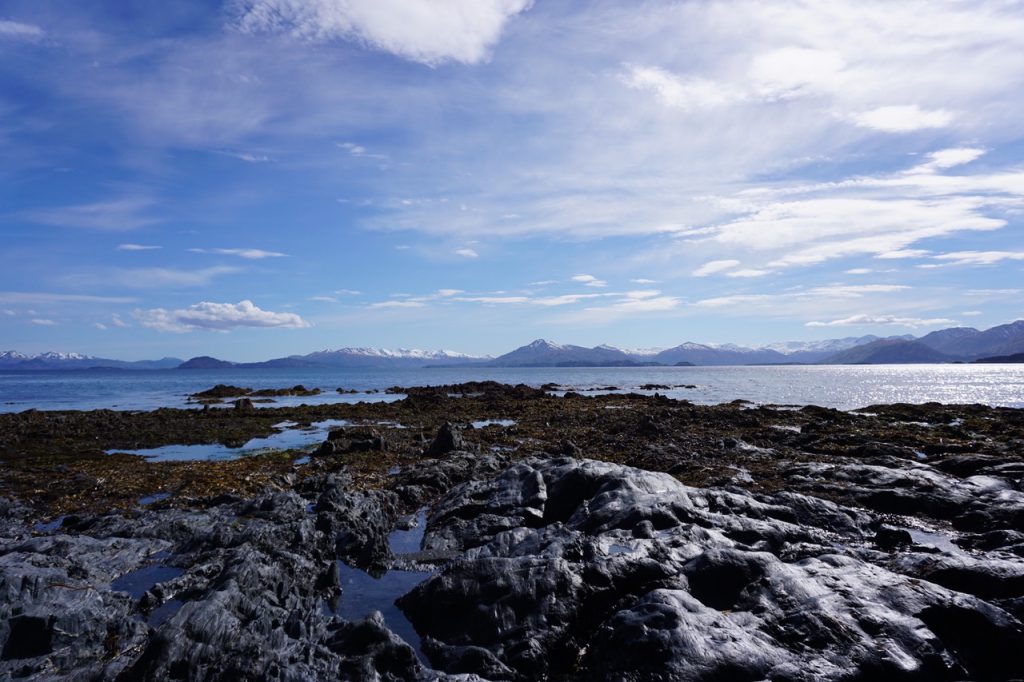Dressing Fish

As an Indigenous poet with background studies in anthropology, the more I have reconnected with my culture through poetics, the more I have questioned academic insistence on distance and objectivity: to observe but not move or be moved by.
I see this tension reemerge in publications’ requests to preserve individual interlocutors’ voices rather than create a composite “character.” Yet in my poems, in their conversation with the storytelling traditions of the Sugpiaq people, who live in or are connected to south-central Alaska, it is not a character they summon on the page but a community.
In my poetics, as in my past anthropology studies, I am interested in how a people’s stories and histories reveal and make accessible alternative perspectives, knowledge, and meaning-making. I’m interested in the patterns and lessons that are preserved and passed from one generation to the next through story, and how the medium itself of story, or poetry, is one that continues to participate in community-making. I am informed by the Sugpiaq invocation to look both ways—to the past and future—and I continue to participate in preserving and adding to my culture and language through my poetry.
My poetics is also informed by absence, erasure, and radical doubt. I did not grow up in Kodiak, Alaska, hearing my ancestors’ stories and histories. As a result of the U.S. government’s assimilation policies for Native Americans and its genocidal boarding school era, my family grew up in Pennsylvania, an hour from the former Carlisle Indian School (now the United States Army War College), where my great-grandfather was sent as a boy in 1901.
What we know of my great-grandfather, Michael Chabitnoy, we have pieced together from incomplete records and tight-lipped memories. He did not return to Alaska when he left the school. It’s unclear if he would have been able to if he would have had the means. Some of his fellow Alaskan “classmates” who did try to return hardly made it back whole.
Michael was an orphan before Carlisle, brought from the Woody Island Baptist Mission on the small island just over from Kodiak. So, we were led to believe, he was in fact fortunate to have the opportunity to attend the school. After leaving Carlisle, he worked for the Hershey’s chocolate company and later making steel. In 1911, he married a White girl from Lebanon, Pennsylvania. I note her Whiteness as she was described in newspaper headlines at the time: “Indian Marries White Girl.”
The records, however, were hardly sufficient—they were particularly lacking in personal affects. When my great-grandfather died when my grandfather was born, the rupture of Carlisle was nearly total. From one perspective, that might have been the end of our connection to the Sugpiaq culture and tradition. A few generations later, White-passing, we might have “moved on,” as the U.S. government desired. But some memories live in the blood, and I’ve always been haunted by the sea.
My first book, How to Dress a Fish, is a docupoetic (documentary + poetic) interrogation of the narrative we were given, that of the “fortunate orphan,” and the larger implications of assimilation policies and erasure of history.
Growing up in Pennsylvania—near the first and one of the largest Native American boarding schools whose horrific history we have yet to fully unpack (though Canada’s own reckoning of First Nations’ boarding school children’s suffering and deaths might be the push we need)—I never heard a negative accusation or anecdote associated with the “school.” I wasn’t taught how children were forcibly taken from their parents, how some parents gave their children up for adoption rather than suffer them to attend boarding schools, how the children were punished for speaking their language, or how they were abused mentally, physically, and sexually.
The more I looked into the history—of Carlisle as well as the larger legacy of Russian colonization in Alaska (1784–1867), also innocently glossed over in our East Coast history books and by my family—I had more questions than answers. Michael was a baseball player, and the athletes of Carlisle were better fed and cared for than the other children. After all, they were key to maintaining appearances. What was Michael’s experience at Carlisle? What would his life have been in Kodiak? What would our lives have been if he had never left? Or if he had returned? In what ways—what meaningful ways—could we still access our family and tradition on that island 4,034 miles away as the crow flies? What had my family gained? What had we lost? Was it a simple, fixed equation?
I write not from a poetics of radical doubt—but from one of radical presence.
My family’s story is not unique. From 1879 to 1918, approximately 12,000 children were sent to Carlisle alone. More than 350 schools were established across 30 states. To walk away, following Michael’s experience, to not look back, would be to affirm the schools’ mission. To forget who we were, who and where we came from.
Those answers, too, are not simple or singular. Who we were, who we are, who and where we come from—this is a complexity, a multiplicity. Beyond reckoning with the impact of Carlisle on my family, there was further the impact of Russian colonization and the U.S. purchase of Alaska from the Russians in 1867. Both eras in history have had a profound impact on Sugpiaq culture and traditional practices.
On Woody Island, questions surround the Baptist mission where Michael lived before Carlisle. Questions of motives. Questions of knowledge: Did the schoolteacher who was brought to that small island know as she got off the boat that she was sick? That the young children soon to be in her care would not be able to fight the illness she carried? Was there record somewhere of those who perished, who were forgotten until unwittingly discovered as foundations were dug for a new summer camp? These questions are largely considered in my poem “When Asked If the World Would End They Answer No.”
Poetry provides me with a way to reconnect with my heritage. I found family in Kodiak and along the Pacific Northwest—and reestablished connections with other descendants of Michael on the East Coast. But it also provides a space in which such questions can be engaged and considered without the need for answers. Conversation is enough.
The Sugt’stun language is one that builds through accretion, just as my knowledge of my culture and heritage builds, just as my ability to see patterns across cultures and histories builds. I am learning the language through songs, often relying on repetition to evolve my own understanding, and through a word-of-the-week archive curated by the Alutiiq Museum with active involvement from language-bearing elders in the community. In these archives, a Sugt’stun word is spoken in a sentence and accompanied by a micro-essay, providing cultural and historical context for the word.
My poems, though primarily in English, are nevertheless influenced by this contextualization through narrative and approach to world-building through language. They engage with historical references to the period of Russian colonization and references to cultural subsistence practice in a demonstration of survivance.
These allusions and patterns are prominent in “Matryoshka Song.” A matryoshka is a Russian nesting doll. In this poem, however, I’m also concerned with stereotypes of Indigenous people and women, more specifically: how histories shape us. “Matrilines” is in conversation with embroidery stitches and traditional tattoos that would have been designed in a manner to indicate family lines. The poem engages my search for family while recognizing the need to adapt.
What histories get written? What stories get told? What do they tell us? Anishinaabe critic and writer Gerald Vizenor defines “survivance” as an active sense of presence over historical absence and assimilation. And so, I write, informed by and in conversation with my past, with all the ghosts—and all the living, and those to come. Perhaps not, then, from a poetics of radical doubt, but one of radical presence.

































